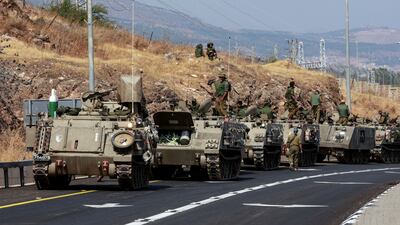Two days after Hamas’s offensive against Israel, many people are wondering whether the conflict between the organisation and Israel can be contained in and around Gaza. Heavy Israeli reinforcements have been deployed to the northern border with Lebanon in the past 24 hours, suggesting that Israel is preparing for a potential conflict with Hezbollah, which would represent a major escalation.
On Sunday, The Wall Street Journal reported that Iran and Hezbollah had co-operated closely with Hamas in organising the attacks of October 7. If that is true, then it suggests a level of planning and co-ordination that makes it highly likely that the parties agreed to what would constitute “red lines” on Israeli retribution, beyond which Hezbollah would enter the battle.
This was more or less confirmed in an article in the pro-Hezbollah Al-Akhbar daily in Beirut on October 9. The newspaper noted that “the forces of the Axis of Resistance established a certain ceiling for what it called the red lines, which the enemy knows, and which, if transgressed under any conditions, will ignite the fronts, perhaps all at once.”

The newspaper did not specify what these red lines were, but its reference, to possible simultaneous responses on various fronts, pointed indirectly to what Hezbollah has called the “unification of the fronts”. This is almost certainly an Iranian-sponsored effort to form a broad front against Israel – from Gaza, Lebanon, perhaps Syria, to possibly the West Bank – and surround the country with a wall of rockets.
This escalation in the confrontation with Israel seems to be serving several purposes: derailing a peace settlement between Saudi Arabia and Israel; showing Israel that Iran has many options to counter Israel’s systematic bombing of Iranian and Hezbollah positions in Syria; and, most importantly, placing Hamas in a position in which it can seize control of the Palestinian cause, to the detriment of the main Fatah movement, and perhaps become the major representative of the Palestinian people that can lead a new armed struggle.
It’s in this broader framework that one must assess what might happen in Lebanon. By highlighting the “unification of the fronts” strategy, Hezbollah cannot stand idly by if Israel threatens Hamas existentially. Nor could it remain inactive if Israeli forces enter Gaza and begin killing many civilians.
But this is where the uncertainty begins. If Israel does enter Gaza and hunts down the Hamas leadership, Hezbollah’s priority would be to open a second (and maybe a third and fourth) front against Israel to halt the Israelis’ momentum. In doing so, it would bring in armed militias from Iraq and perhaps Yemen to bolster its forces, which could widen the scope of operations.
Once that happens, it would mean a radical intensification of the conflict and the very real prospect that it mutates into a regional war. Under those circumstances, Israel’s military actions may come to encompass Iran, which could draw in the US, leading to an extremely dangerous situation globally.
However, all the parties are aware of this, and even more so that the outcome of such a conflagration would be highly unpredictable. Therefore, it is more likely than not that the Axis of Resistance parties have considered off-ramps to avoid such a result. Having scored a harsh blow against Israel, it makes more sense for them to pause and exploit their success politically, than to enter into a war whose ultimate consequences may actually weaken the Axis of Resistance.
Where would these off-ramps lie? First, in Hezbollah’s trigger to enter the fray once Israeli forces enter Gaza. By not defining clear Israeli red lines yet, Hezbollah may be trying to avoid locking itself into a situation in which it has to escalate. Second, the nature of its retaliation may vary. If Hamas is being bludgeoned by Israel but is otherwise holding its own in the Gaza battle, Hezbollah might determine that it has no need to open a new front, beyond relatively limited attacks against Israel.
Ironically, Israeli thinking might be closer to Hezbollah’s than we know. Israel, too, may not relish a regional war. Therefore, it too could accept an unwritten understanding with Hezbollah that grants the party a degree of latitude to strike Israeli targets, beyond which Israel would hit Lebanon very hard.
Would this be unheard of? Not really. During its occupation of Lebanon, Israel and, indirectly, Hezbollah agreed to the 1996 April Understanding, aimed at avoiding civilian casualties and Hezbollah’s bombing of Israel. However, the agreement’s implicit dimension was that if Israel failed to live up to its end of the bargain and killed or injured civilians, it would consider Hezbollah’s retaliation against Israeli territory as being within the acceptable rules of the game.
All sides have an interest in averting a regional explosion, but it’s important to note that if the conflict in Gaza spreads to Lebanon, this would be much more probable. Moreover, Israel's major concern is the fate of the dozens of Israelis the Palestinians have abducted, whose numbers Al-Akhbar has placed, reliably or not, at 130 people.
Hezbollah, in turn, would have to explain a devastating war to a Lebanese public that in its majority strongly opposes what Hezbollah is doing today. This comes at a time when Lebanon’s economy has collapsed and the Lebanese are disgusted.
All this is not to say a generalised war may not happen, but that all the parties probably do not regard it as the most desirable option if they can save face by engaging in lesser actions that preserve their deterrence capability. What we may conceivably see in the coming period is an effort by the sides to tiptoe between raindrops to avoid a major war. But how easy is it to tiptoe between raindrops?


